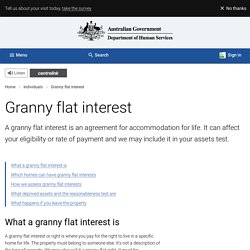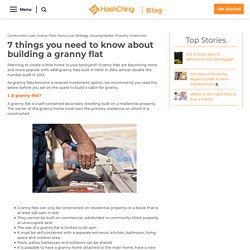

Granny flat interest. What a granny flat interest is A granny flat interest or right is where you pay for the right to live in a specific home for life.

The property must belong to someone else. It's not a description of the type of property. We may also call it a granny flat right. It must be: all or part of a private residence your principal home not owned by you, your partner or a trust or company you control. The right only lasts for your lifetime. Which homes can have granny flat interests You can have a granny flat interest in any kind of property. Granny flat interests are usually family arrangements providing company and nearby help for older people. The interest may include: the same building as the owner of the home a separate, self-contained building on someone else's land. The Rise of the Backyard 'Granny Flat' When Kol Peterson moved to Portland, Oregon, in 2010, affordable housing was a priority, as it was for many newcomers in this city’s booming real-estate market.

He looked at two frequently discussed options for high-cost cities—tiny houses on wheels and communal living—but decided on another option: accessory dwelling units, or ADUs—also known as granny flats, basement and garage apartments, and the like. ADUs weren’t yet common in Portland—that year, the city issued only 86 permits for them—but when Peterson did the math he decided that building one was his best option. “I could buy a house, construct an ADU in the backyard, and live in the ADU while renting out the house,” he said. That’s what he did: He bought a home in the city’s King/Sabin neighborhood, built a tidy two-story mini-home in its backyard, and moved in. The experience, he says, has been life-changing. “By 2020, ADUs will take off in tens of cities,” he said. ADUs allow people housing flexibility over time. Designed for one or two persons, a granny flat is a... - GraceHenson0910. Audio: Popular granny flats create a niche industry in LA.
This time last year, Andrei Pogany's Los Angeles-based home design business was centered on single-family houses and additions.

But in recent months, half of his work has been designing accessory dwelling units, or "granny flats" — which he expects to become an even bigger chunk of his business as Angelenos embrace small backyard homes at a pace not seen elsewhere in California. "Not to sound architecturally nerdy, but they're fun," said Pogany, who's started a granny flat blog. "It's like building a new house, but they're smaller so we can do them faster. " A new niche business is opening up for architects and builders as the application rate for accessory dwelling units in Los Angeles far outpaces any other major California city.
L.A.' Garcia said he wasn't surprised by the burst of applications in Los Angeles, given the region's need for affordable housing. L.A. "We think it's going to be the next big thing in L.A. ," he said. Leavitt said the hope is to have prototypes ready by spring. The pros and cons of building a granny flat. Gone are the days when the typical suburban backyard was a stretch of lawn and a hills hoist.

With space at a premium, Australians are now looking to their backyards as an opportunity to increase their living space as well as add value to their property. As a result, the humble granny flat has experienced a resurgence in recent years. But does building a granny flat make sense for your own property? These are the pros and cons you’ll need to consider. Pro: More flexible living arrangements. 7 Things You Need to Know About Building a Granny Flat. Planning to create a little home in your backyard?

Granny flats are becoming more and more popular with 4818 granny flats built in NSW in 2014, almost double the number built in 2013. As granny flats become a revered investment option, we recommend you read the below before you set on the quest to build a cabin for granny. 1. Granny Flat Rights – Julia's Blog. Granny Flat Rights Centrelink offer some excellent pension concessions for parents to build a granny flat in their child’s back yard or modify the house etc.

With raising awareness of elder abuse Centrelink also strongly encourage parents to obtain a right of occupancy over their child’s house. This would take the form of a life time right to reside for ATO purposes. Download PDF While Centrelink is busy protecting its customers, another government department, the ATO, is having a field day taxing their children on the value of this right with no main residence exemption and no 50% CGT discount. In November 2018 the government finally announce that they would review the law. There is a simple way around the problem. The child does not give the parent any right to occupy, just take their money and say trust me. This is how it works. The child gives their parent a life time right to reside in their home without actually selling them part of the home.
The next issue. Backspace Living, Affordable Designer Granny Flats - Newcastle, Cardiff, Newport, Gateshead.